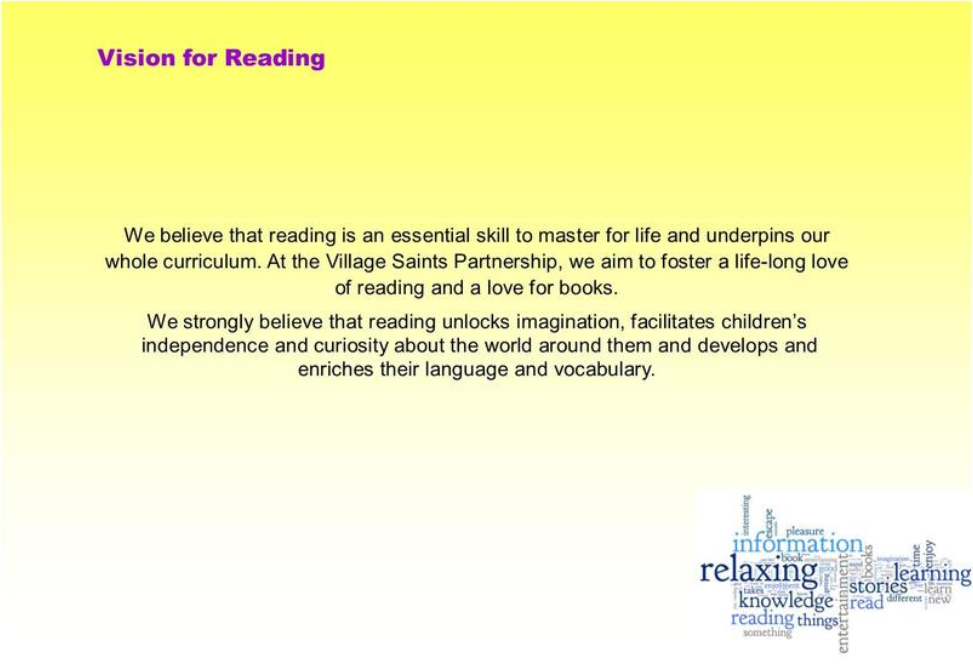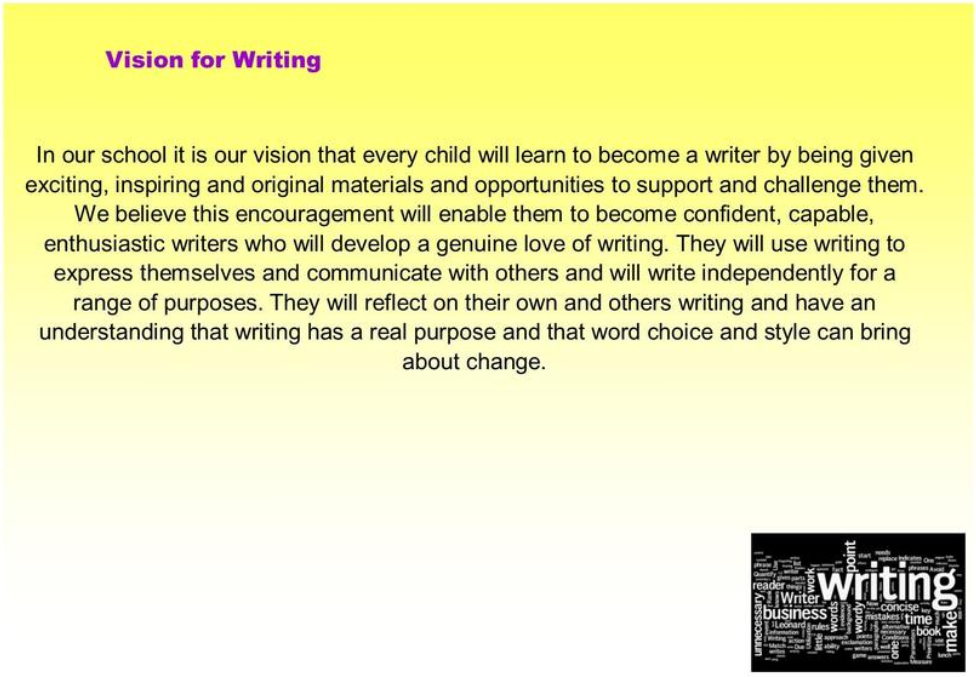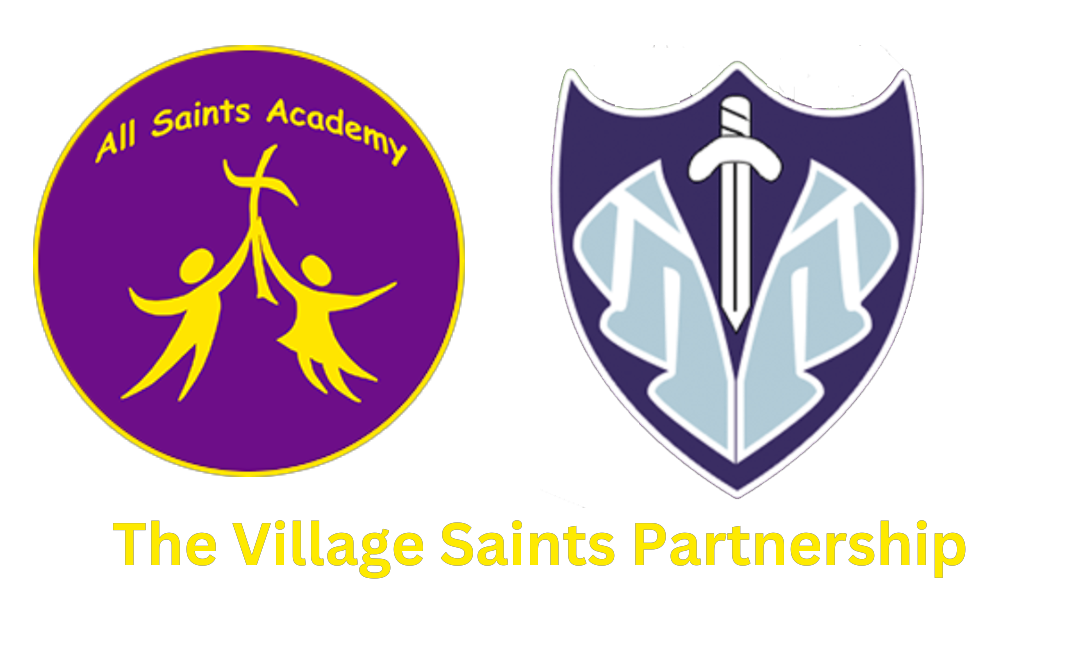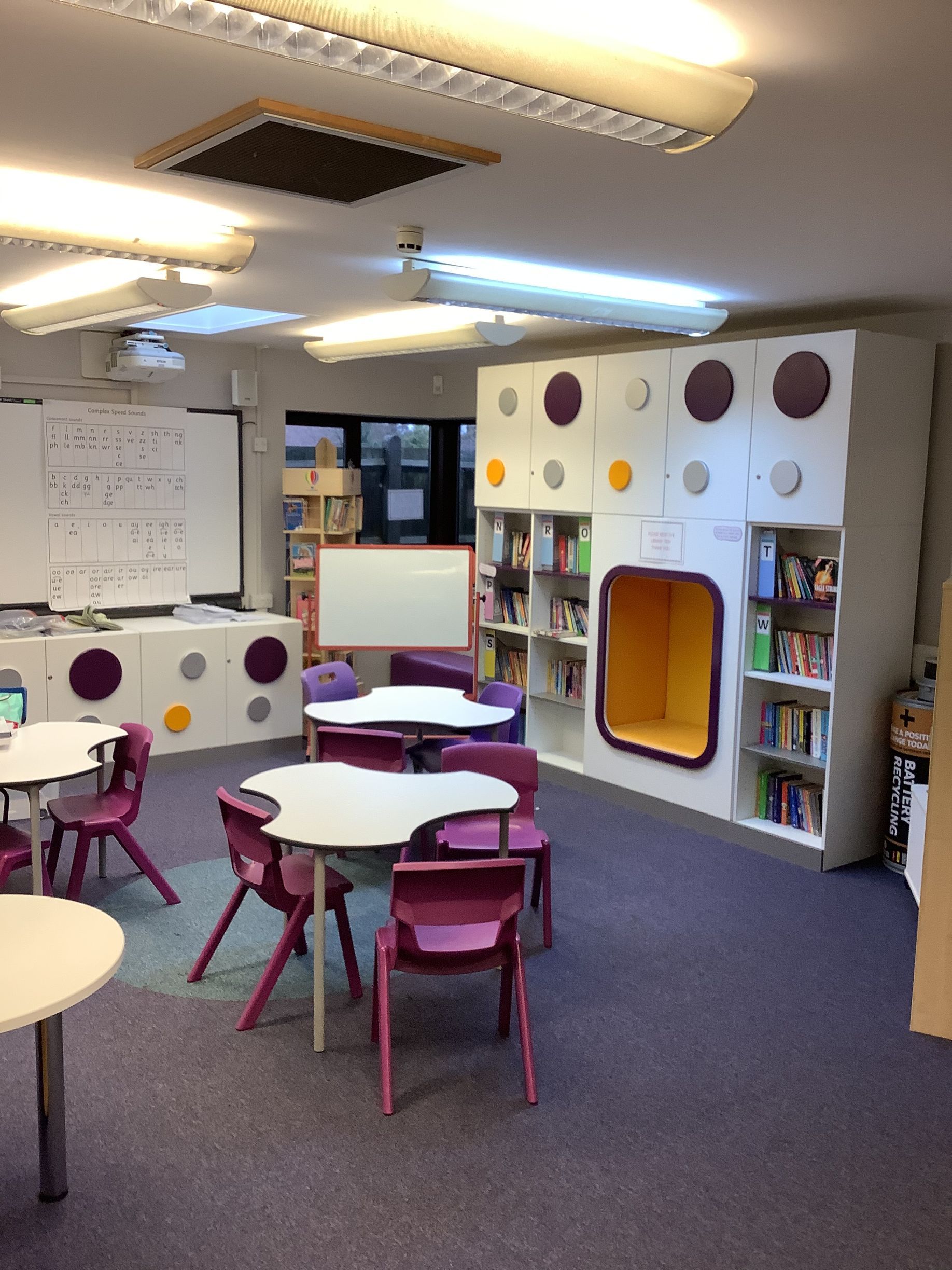
English Curriculum
Respecting, Generous and Achieving, Loving All Our Neighbours.
Welcome to English!
At The Village Saints Partnership we believe all our children (from Nursery to Y6) are entitled to an ambitious, knowledge-rich English curriculum that ensures they will become fluent readers and writers who are able to confidently access the demands of the secondary school curriculum. Our English curriculum is driven by a cannon of culturally important, high-quality texts. This is the stimulus for all our reading and writing. We have chosen texts which lead to the development of the personal and cultural capital of children at The Village Saints Partnership. We believe that in order for our children to leave The Village Saints Partnership as successful learners, they need to have a knowledge of a range of these texts.
Phonics
At The Village Saints Partnership we teach children to decode (read the words on the page) using the Read Write Inc. phonics programme. This programme teaches children to read accurately and fluently and with understanding to spell. Children will study three main skills to enable them to read: blending, the skills of blending letters together; segmenting, separating sounds for spelling; and manipulating, swapping sounds to develop reading accuracy.
All teachers receive extensive Read Write Inc. training to support them to deliver the phonics lessons and yearly refresher training. The programme takes the children step-by-step through phonics, introducing them to the 44 different sounds in the English language and their different spellings gradually and systematically. The programme is highly specified, carefully sequenced and code knowledge is revisited so that it is taught to be remembered.
Reading
In YR and Y1, children practice reading the words on the page by reading texts that are fully aligned to our phonics programme. It is vital that children develop their code knowledge to automaticity, so they will practice reading from the same decodable text for several days until they are completely fluent. In addition, they listen to texts read to them from our reading cannon to ensure they experience a rich reading diet that develops their vocabulary and background knowledge. As their code knowledge increases, children begin to read aloud texts from the reading cannon. When learning to decode, children will take home a phonically controlled text to practise the mechanics of reading and they will also take home a language rich library book to share with a family member. Once children have learnt sufficient code, the texts they take home will be selected by them with support from their class teacher.
To optimise reading fluency, all children read aloud in whole class reading lessons. This may be individually, through echo reading or repeated reading. All children read the text as secondary readers, while the primary reader is reading aloud to maximise the amount of reading done by every child in the lesson. We pitch the text above national reading level for each age group in order to develop children's ability to read effortlessly over large sections of academic text as they progress through the school. We set our expectations high and anticipate that children will meet those expectations.
Across the whole partnership, specific reading techniques are used to ensure that all children join in with reading aloud. These include repeated reading and close reading of sections of text. Additional scaffolding may be required for the slower graspers and children may pre-read the text with an adult ahead of the whole class lesson. Teachers plan in advance which child reads which part of the text in order to push the faster graspers with more complex vocabulary or allowing opportunities for fluency for the slower graspers. As well as whole class reading aloud, there are regular opportunities for 'close reading' and 'art of the sentence' where children are expected to answer questions and write specified sentences about the passage of text they have just read. After writing, the class then have an in-depth discussion about the passage they have just read. Teachers also carefully select vocabulary to teach explicitly and implicitly from the text and children are given plentiful opportunities to pronounce the word and use it orally in a variety of contexts. We give children child-friendly definitions and do not promote guessing definitions. We run our reading lessons in this way in order to expose children to high-quality literature and develop their fluency and prosody, a well as to increase their vocabulary breadth and depth.
Please Find Reading List for Year Groups
Writing
At The Village Saints Partnership we focus on teaching six text types: recount, report, instructional, explanation, discussion and persuasive texts. The text types are introduced and revisited in a specified sequence to reduce cognitive load. Additionally, the core grammar knowledge for each phase (KS1, LKS2, UKS2) is specified and carefully sequenced so that children have plentiful opportunities to learn the skills and practice them to automaticity. Once children are ready to apply these skills, they draft extended piece. The writing outcomes are based on content from the text read and discussed in the whole class reading lessons or from previously taught content in foundation subjects. Again, this is to ensure the focus is on thinking about grammar, punctuation, and vocabulary choices, rather than making up content, which is something children do naturally when we use rich texts. In early years, the focus is on oral language development, however children will be exposed to writing through encoding the sounds they hear in their phonics lessons. There are opportunities for writing within continuous provision, but children will not be expected to write extended pieces until they are developmentally ready.
This planning process begins with identifying the purpose for writing- to entertain, to inform, to persuade or to discuss. The skills needed for each writing purpose are built and the children have time to practice and consolidate this learning.
Children are taught explicitly how to plan their writing and extensive time is spent re-drafting, so that all children carefully consider the choices they are making. This ensures that every child can become a competent and successful writer. We believe in improving the writer not improving a single piece of writing. The cycle of drafting, responding to feedback and redrafting is repeated until children publish a piece of extended writing. This enables the taught grammar and punctuation to become embedded, so that children think carefully about their language choices and apply this in new pieces of writing across the curriculum.
Handwriting
Fluent handwriting is crucial to allow children to think about what, not how, they are writing. We teach and practise handwriting discretely to the point where children no longer have to think about how they are forming, and later joining, their letters. At The Village Saints Partnership, we use the Nelson Handwriting script. The handwriting patter can be found at the bottom of this page and we encourage children to practise at home. Fluid, automatic handwriting with the correct pencil grip and posture and position is key to writing fluency.
Assessment
Formative (at the point of teaching) assessment takes place in every lesson through regular quizzing of the children to check their understanding. This includes spelling tests from the statutory word lists and key vocabulary, as well as factual information of the context and knowledge of grammatical functions. Previous learning is revisited in the quizzes to embed the knowledge within the long-term memory. The children have half-termly phonics assessments to check for decoding ability and fluency testing using DIBELS.
We assess children's writing termly against our KLI (key learning indicators), and moderate within clusters across our trust. Additionally, every year group participates in a system called Assessing Primary Writing once a year, where children's writing is judged anonymously and ranked with other children nationally. This supports our professional judgements and shows us how our children's writing compares across the country.


Useful Links:
Please Ensure you Read with your Child Daily.

